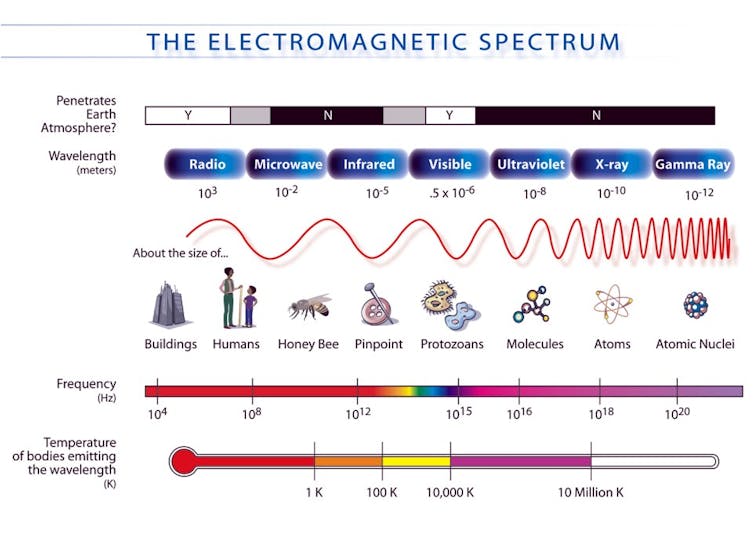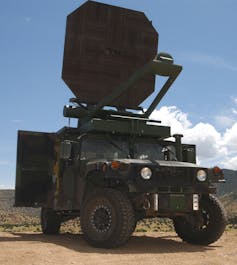.jpg?ext=.jpg)
Friday, 6 September 2024
Fuel debris removal attempt halted at Fukushima Daiichi
.jpg?ext=.jpg)
Monday, 23 October 2023
How the Israel-Hamas war could affect the world economy and worsen global trade tensions

Rawpixel.com/Shutterstock Daniele Bianchi, Queen Mary University of London
Global geopolitical tensions often play a pivotal role in shaping people’s perceptions of economic growth. Research shows concern about such issues can cause people and businesses to become more cautious about spending and investing, which can ultimately lead to economic recession.
The recent escalation of the Israel-Palestine conflict is no different. Investors around the world are worried about the repercussions of this war – particularly in light of an already bleak picture for global economic growth.
Hamas’s October 7 attack on southern Israel is the latest chapter of a cycle of violence that has been going on in this region for decades and, sadly, seems to have no end in sight. While the reasons behind these events are complex, the conflict’s potential immediate and long-term economic ramifications are easier to grasp.
After all, if the Russia-Ukraine war has taught us one thing, it’s that we should be mindful of the intricate interdependencies that shape the global economic and geopolitical landscape.
How conflicts can affect the economy
Internal and inter-state conflicts often have a significant effect on stock market indices, exchange rates, and commodity prices – sometimes even sending prices higher in the lead-up to hostilities. The longer-term economic impact is typically more complicated to assess, however. The lasting effects of even seemingly dramatic events on investor behaviour can be hard to predict.
Conflicts in the Middle East tend to lead to spikes in oil prices – think of the OPEC oil embargo of 1973-1974, the Iranian revolution of 1978-1979, the Iran-Iraq War initiated in 1980, and the first Persian Gulf War in 1990-91. Since the region accounts for nearly a third of global oil supply, any instability can create market uncertainty based on concerns about interruptions to global oil supply.
This uncertainty is reflected in the risk premium in oil markets. This is the price paid for oil traded ahead of time in the futures markets versus the real-time price of oil. It reflects the profits that speculators expect to receive from buying and selling oil during a time of conflict, as well as the hedging needs of businesses that produce and consume oil and their concerns about supply and demand.
And so, the effect of the latest Israel-Hamas conflict on global financial markets will depend on the involvement of other major regional powers. If the conflict remains between Israel and Hamas, the effect will probably be limited and arguably exclusive to countries with direct trade exposure to Israel or Palestine.
But if the conflict spreads to major oil-producing nations in the region such as Iran, the global economy could face severe repercussions as energy costs for businesses and households could spike if supply is interrupted.
Higher energy prices would hamper central banks’ efforts to tame inflation pressures in most advanced and emerging economies. If this leads to a “higher for longer” monetary policy that keeps interest rates elevated, it would push up the cost of borrowing and refinancing by governments, companies and people.
History can offer some insights into how the impact on the global economy could unfold under these different scenarios. For instance, the 50-day war between Israel and Hamas in 2014, which killed 2,200 people, mostly civilians, had no significant effect on the global economy or financial markets.
Yet, when Israel and Hezbollah clashed in Lebanon in 2006, oil prices surged globally due to fears of a broader conflict in the Middle East.
What to expect this time
Unfortunately, there is another factor to consider at the moment. The escalation of the Israel-Palestine conflict has happened alongside the realignment of various global alliances. This slow creep of “deglobalisation” can be seen in a shift in trade policies in recent years.
Countries such as the US and UK are relocating economic activity including sourcing or manufacturing products from different countries out of concern about relying on suppliers in potentially hostile regions, as well as the impact of imports from low-wage countries on struggling local labour markets
At the moment, these shifts can also be seen in the reactions to the Hamas attack on Israel. A two-state solution) to the Israel/Palestine conflict was initially laid out by the United Nations in 1947 and reaffirmed in 1974, with almost unanimous support around the world.
But there has been some nuance in the international reactions to the attack. With most western countries quickly voicing support for Israel’s right to defend itself, while countries like China and Russia called for a ceasefire without taking a stance on Hamas.
This suggests that the issue of Israel-Palestine could tie in with the broader trend towards the new geopolitical divisions that were already starting to emerge before Hamas’s attack.

Under these circumstances, investors are already bracing for increased financial volatility across the board – from stocks and government bonds to commodity markets. So-called safe-haven assets like gold are typically used as protection against overwhelming economic uncertainty. The price of gold has shot up following the latest escalation in the Israel-Palestine conflict.
Financial markets will continue to monitor the conflict between Israel and Hamas for signs of escalation. Anything that pushes oil prices up further will reignite fears of higher inflation.
Unfortunately, this is happening just as many countries were starting to see inflation slow again after two years of persistently high consumer prices.![]()
Daniele Bianchi, Associate Professor of Finance, Queen Mary University of London
This article is republished from The Conversation under a Creative Commons license. Read the original article.
Tuesday, 4 October 2022
Directed energy weapons shoot painful but non-lethal beams – are similar weapons behind the Havana syndrome?


Monday, 26 September 2022
France, US hail PM Modi's advice to Putin over Ukraine
Monday, 5 September 2022
BSF organizes 'Run up to Teachers' Day' in Dhubri district

Monday, 8 August 2022
India is a strong defense power in the world and now its impossible to become a defense threat against India.

- List of Countries with nuclear weapons
1. Russia 5,9772. United States 5,4283.China 3504.France 2905. United Kingdom 2256. Pakistan 1657.India 1608.Israel 909.North Korea 20
- Top 10 Countries with the Highest Number of Active-Duty Military Personnel (in members):
- Top 10 Countries with the Highest Number of Active-Duty and Reserve Military Personnel (in members
- Vietnam: 5,482,000
- South Korea: 3,699,000
- China: 3,355,000
- Russian Federation: 3,014,000
- India: 2,610,550
- United States: 2,233,050
- North Korea: 1,880,000
- Taiwan: 1,820,000
- Brazil: 1,706,500
- Pakistan: 1,204,000
- Largest militaries in the world by budget (Military Budget 2021 (in USD billions)
1. United States: 778.02. China: 252.03. India: 72.94. Russia: 61.75. United Kingdom: 59.26. Saudi Arabia:: 57.57. Germany: 52.88. France: 52.79. Japan: 49.110. South Korea: 45.711. Italy: 28.912. Australia: 27.513. Canada: 22.814. Israel: 21.715. Brazil: 19.7
- Top 10 Largest Air Forces in the World (by number of Military Aircraft) - Flight International 2022:
- United States Air Force - 5,217
- Russian Air Force - 3,863
- People's Liberation Army Air Force (China) - 1991
- Indian Air Force - 1,715
- Egyptian Air Force - 1,062
- Korean People's Army Air Force (North Korea) - 946
- South Korean Air Force - 898
- Pakistan Air Force - 810
- Japan Air Self-Defense Force - 746
- Royal Saudi Air Force - 690
- Top 10 Largest Navies in the World (by total number of warships and submarines - 2020):
- Foreseeing the future: The top 5 navies in the world by 2030
United States - The U.S. is expected to remain the dominant global naval power in 2030, thanks to an unmatched combination of sheer tonnage and technological advancement. The U.S. Navy doesn't just have many ships, it has many massive, cutting-edge ships.
United Kingdom - While the U.K.'s total number of ships is expected to decline, the addition of two new aircraft carriers and the progressive updating of its submarine fleet should establish the U.K. as the #2 maritime power.
China - The People's Liberation Army Navy (PLAN) fleet is older, but larger in number (if not tonnage) fleet than the U.S. Navy fleet, and the PLAN has ambitious plans to keep adding more and more vessels.
India - Another Asian country expanding its naval presence, India should have three operating aircraft carriers by 2030, collectively capable of deploying 110-120 aircraft.
Russia - This superpower's aging fleet is likely to suffer some budget constraints as older equipment is decommissioned, but Russia is still expected to have eight ballistic missile submarines (with 20 missiles each) patrolling the seas in 2030.
- India: Land-based ballistic missiles
- Prithvi-I Short-range ballistic missile: Range 150 KM.
- Prithvi-II Short-range ballistic missile: Range 250–350 KM
- Prithvi-III Short-range ballistic missile: Range: 350–600 KM
- Agni-I Medium-range ballistic missile: Range: 700 KM
- Shaurya Medium-range ballistic missile: Range: 700-1900 KM
- Agni-P Medium-range ballistic missile: Range: 1,000–2,000 KM
- Agni-II Medium-range ballistic missile: Range: 2,000–3,000 KM
- Agni-III Intermediate-range ballistic missile: Range: 3,500–5,000 KM
- Agni-IV Intermediate-range ballistic missile: Range: 4000 KM
- Agni-V Intercontinental ballistic missile: Range 5,000–8,000 KM
- Agni-VI Intercontinental ballistic missile & MIRV capable: Range: 8000–12,000 KM, Under development
Thursday, 23 June 2022
USA ,NATO Must need to provide, Nuclear weapons to Taiwan, Japan and South Korea to maintain world Defense balance
Wednesday, 8 June 2022
North Korea nuclear tests any time, warns US official

Wednesday, 25 May 2022
Biden warns China against invading Taiwan

Monday, 3 May 2021
Russia to expand defence co-operation with India
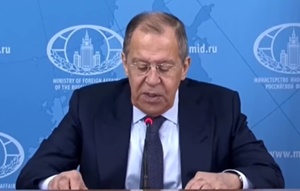
- India and Russia have decided to expand their military cooperation with additional production of Russian military equipment in India under Prime Minister Narendra Modi’s `Make-in-India’ programme, visiting Russian foreign minister Sergei Lavrov said after meeting his counterpart S Jaishankar in New Delhi on Tuesday.
- The two countries also decided to pursue bilateral cooperation despite dissuations caused by regional and global developments. Moscow and New Delhi also reassured themselves that neither threats of sanctions from the United States nor military threat posed by China will stand in the way of bilateral trade and defence ties.
- Lavrov said talks touched on manufacturing of state-of-the-art weapon systems, even as he noted that Russia is the only partner that transfers cutting-edge military technology to India.
- “In this strategically important area, Russia is a major foreign contractor for New Delhi. I am sure deepening of Russian Indian military cooperation serves the national interest of both countries,” said Lavrov.
- Lavrov said military ties with India were deepening while ruling out any military alliance with China. The statement is significant considering the India-China military standoff for nearly a year in East Ladakh.
- Speaking alongside Indian external affairs minister S Jaishankar, Lavrov also spoke of Russia manufacturing 750 million doses of the Sputnik-V vaccine in India. Discussions about the manufacture of the Bharat Biotech in Russia are on, he said .
- The two foreign ministers also discussed the Afghanistan situation and agreed on the involvement of the Taliban and other regional powers, without which any solution would be "unsustainable."
- Lavrov also said that Moscow respected India's decision to diversify the purchase of military weapons from other countries, a reference to the United States and France, adding that Russia has assurances that there was no plan for an Asian NATO.
- Denying that he had said US exercises pressure on India, Lavrov said there were no discussions on statements from the US against arms trade with Russia.
- Both sides also touched on cooperation in energy, including nuclear, peaceful exploration of space and manned programs, rocket engine building, satellite navigation, the Russian Far East and the Arctic.Fresh from a meeting with Chinese Foreign Minister Wang Yi last month, Lavrov said though Russia-China relations at the summit-level are at their highest levels in history; there are no discussions on a military alliance. Whether it was a Russia-China military alliance or talks of a Middle East NATO or an Asian NATO, “we believe it is counterproductive. Our Indian friends have the same position,” he observed. Source: https://www.domain-b.com/
Wednesday, 17 March 2021
DRDO successfully flight-tests solid fuel ducted ramjet technology for air-to-air missiles
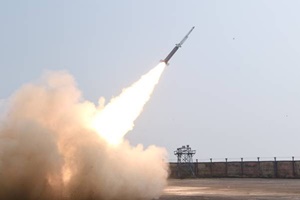
- Defence Research and Development Organisation (DRDO) today successfully carried out a flight demonstration based on Solid Fuel Ducted Ramjet (SFDR) technology from the Integrated Test Range Chandipur off the coast of Odisha at around 1030 hrs.
- DRDO said all the subsystems, including the booster motor and nozzle-less motor, performed as expected. During the test, many new technologies were proven, including Solid Fuel based Ducted Ramjet technology, it added.
- The successful demonstration of Solid Fuel based Ducted Ramjet technology will enable DRDO to develop long range air-to-air missiles. At present, such technology is available only with a handful of countries in the world.
- During the test, air launch scenario was simulated using a booster motor. Subsequently, the nozzle-less booster accelerated it to the required Mach number for Ramjet operation.
- The performance of the missile was monitored using data captured by electro optical, radar and telemetry instruments deployed by ITR and confirmed successful demonstration of the mission objectives. The launch was monitored by senior scientists of various DRDO labs, including Defence Research & Development Laboratory (DRDL), Research Centre Imarat (RCI) and High Energy Materials Research Laboratory (HEMRL).
- Defence minister Rajnath Singh congratulated DRDO scientists, Indian Air Force and the industry on the successful flight test of SFDR.Secretary Department of Defence R&D and chairman DRDO G Satheesh Reddy also congratulated the team involved in the successful flight test. Source: https://www.domain-b.com/
Friday, 19 February 2021
Suu Kyi faces second charge by military

Thursday, 18 February 2021
India approves 156 defence equipment for export

- India on Thursday approved the export of 156 defence equipment, including Astra missiles and Tejas indigenous Light Combat Aircraft, artillery guns, explosive, tanks and missiles, anti-tank mines and others, worth an estimated Rs35,000 crore, as the government is looking at enhancing defence exports to friendly countries.
- The export list also includes 19 aeronautical systems, 16 nuclear-biological-chemical equipment, 41 armament and combat systems, 28 naval systems, 27 electronic and communication systems, 10 life protection items, four missile systems, four micro-electronic devices and seven other material.
- Defence Research Development Organisation (DRD0) released the extended list, which now includes even Beyond Visual Range (BVR) air-to-air missile Astra, anti-tank guided missile Nag and Brahmos weapon system.
- Earlier, it was the Akash missile that was given clearance for export.
- Akash is a surface-to-air missile system that provides short-range air defence and can operate in autonomous or group modes of operation with a range of three to 25 km.
- The Astra missile is a beyond-visual air-to-air system integrated with Indian Air Force's Su30 MKI. In times to come, other Indian fighter jets will also be integrated with the Astra.
- Brahmos is a supersonic missile intended for use by the Army, Navy and Air Force. This universal missile can be launched from ships, mobile launchers, submarines and aircraft.
- The government is now looking at enhancing its defence exports, aiming to record export of defence equipment worth Rs35,000 crore ($5 billion) by 2025, as per the Defence Production Export Promotion Policy 2020.
- The new policy aims at enhancing exports and building a domestic defence industry for self-reliance, and targets a turnover of Rs1,75,000 crore ($25 billion dollars) by 2025.
- The policy also looks at doubling the domestic procurement from the Indian industry. Source: https://www.domain-b.com/
China, India say disengagement of troops started at Pangong Tso

- After a bloody fight that left 20 Indian soldiers dead and a border standoff that lasted several months, Chinese and Indian troops have finally started simultaneously pulling back from the Pangong Tso Lake in Ladakh, as part of an agreement reached during the last round of military talks.
- The Chinese defence ministry said on Wednesday that troops on both sides have begun simultaneous pullback, which was also confirmed by India’s defence minister Rajnath Singh in Parliament on Thursday.
- “The Chinese and Indian frontline troops at the southern and northern bank of the Pangong Tso Lake started synchronised and organised disengagement from 10 February," China’s defence ministry spokesman senior colonel Wu Qian said.
- “This move is in accordance with the consensus reached by both sides at the 9th round of China-India corps commander level meeting," Wu said in a written statement put up on the ministry website.
- In New Delhi, defence minister Rajnath Singh said on Thursday that there was progress on the disengagement issue after nine months. He gave full credit to Indian troops for making China agree to disengage their forces.
- Tensions have been running high between India and China for nine months since India first detected Chinese intrusions into its territory in May. India quickly mobilized troops to match the Chinese deployment that Singh said had started in April last year.
- Last month, foreign minister S. Jaishankar warned ties were “truly at a crossroads" and that “choices that are made will have profound repercussions, not just for the two nations but for the entire world".
- Over the weekend, Jaishankar acknowledged some progress in dialogue but added that this had not eased the situation.
- However, reports citing sources said India was moving out some armoured components, while also “thinning out of troops" from the rear on the Indian side.
- “We continue to hold strategic heights. Frontline troops are not disengaging at the moment. It is still early days," the report cited one source as saying.
- He declined to confirm if the development could be described as “disengagement. “It’s a multi-step process, and there will be verification at each stage," the person said.
- According to strategic analysts, India’s cautious response is understandable, given the tense situation on the ground.
- “We will not judge the Chinese by their words, we will judge them by their actions," said former Indian ambassador to China Gautam Bambawale.Even if there is disengagement of troops, “the trust deficit between both sides will not be bridged, considering that the Chinese have gone back on almost all the agreements they have signed in decades to stabilise the border," said the second person cited above. Source: https://www.domain-b.com
Sunday, 7 February 2021
India approves 156 defence equipment for export

- India on Thursday approved the export of 156 defence equipment, including Astra missiles and Tejas indigenous Light Combat Aircraft, artillery guns, explosive, tanks and missiles, anti-tank mines and others, worth an estimated Rs35,000 crore, as the government is looking at enhancing defence exports to friendly countries.
- The export list also includes 19 aeronautical systems, 16 nuclear-biological-chemical equipment, 41 armament and combat systems, 28 naval systems, 27 electronic and communication systems, 10 life protection items, four missile systems, four micro-electronic devices and seven other material.
- Defence Research Development Organisation (DRD0) released the extended list, which now includes even Beyond Visual Range (BVR) air-to-air missile Astra, anti-tank guided missile Nag and Brahmos weapon system.
- Earlier, it was the Akash missile that was given clearance for export.
- Akash is a surface-to-air missile system that provides short-range air defence and can operate in autonomous or group modes of operation with a range of three to 25 km.
- The Astra missile is a beyond-visual air-to-air system integrated with Indian Air Force's Su30 MKI. In times to come, other Indian fighter jets will also be integrated with the Astra.
- Brahmos is a supersonic missile intended for use by the Army, Navy and Air Force. This universal missile can be launched from ships, mobile launchers, submarines and aircraft.
- The government is now looking at enhancing its defence exports, aiming to record export of defence equipment worth Rs35,000 crore ($5 billion) by 2025, as per the Defence Production Export Promotion Policy 2020.
- The new policy aims at enhancing exports and building a domestic defence industry for self-reliance, and targets a turnover of Rs1,75,000 crore ($25 billion dollars) by 2025.The policy also looks at doubling the domestic procurement from the Indian industry. Source: https://www.domain-b.com/
Thursday, 28 January 2021
US military in Iraq targeted again

Saturday, 9 January 2021
Indian Army rescues pregnant woman stuck in snowbound Kashmir
Soldiers of the Indian Army rescued a pregnant woman stuck in snowbound Kupwara in Kashmir and safely took her for about two km in knee-deep snow tol the hospital, the Indian Army said on Thursday.
Tuesday, 5 January 2021
Taliban commander among 13 killed in Afghan airstrikes

Saturday, 2 January 2021
India, Pakistan exchange lists of nuclear installations, prisoner

Friday, 1 January 2021
Lockheed Martin to acquire Aerojet Rocketdyne for $4.4 billion
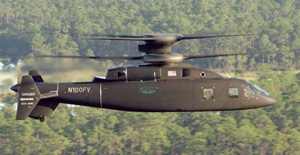
- US defence major Lockheed Martin Corporation on Sunday announced the signing of an agreement to acquire rocket engine manufacturer Aerojet Rocketdyne Holdings Inc for $4.4 billion, including debt and net cash, or $56 per share in cash.
- Lockheed Martin would be paying $51 per share after the payment of a pre-closing special dividend. This represents a post-dividend equity value of $4.6 billion and a total transaction value of $4.4 billion, including the assumption of net cash.
- The deal is Lockheed’s biggest acquisition since Jim Taiclet took over as chief executive in June. He is seeking to beef up the company’s propulsion capabilities amid competition from new entrants such as SpaceX and Blue Origin, for space contracts with the US government.
- As part of approving the transaction, Aerojet Rocketdyne announced a special cash dividend, revocable at its option through the payment date, of $5 per share to its holders of record of common stock and convertible senior notes (on an as-converted basis) as of the close of business on 10 March 2021, and payable on 24 March 2021
- Aerojet Rocketdyne's complementary capabilities and skilled workforce will help Lockheed Martin achieve substantial growth in Hypersonics, Tactical Missiles, Integrated Air and Missile Defense, Strategic Systems and Space Exploration.
- "Acquiring Aerojet Rocketdyne will preserve and strengthen an essential component of the domestic defense industrial base and reduce costs for our customers and the American taxpayer," said James Taiclet, Lockheed Martin president and CEO.
- "This transaction enhances Lockheed Martin's support of critical U.S. and allied security missions and retains national leadership in space and hypersonic technology. We look forward to welcoming their talented team and expanding Lockheed Martin's position as the leading provider of 21st century warfare solutions," he added.
- With 2019 revenue of approximately $2 billion, nearly 5,000 employees, and 15 primary operations sites across the United States, Aerojet Rocketdyne is an established aerospace and defense rocket engine manufacturer.
- The proposed acquisition adds substantial expertise in propulsion to Lockheed Martin's portfolio, and expands on the solid foundation built by Lockheed Martin and Aerojet Rocketdyne over many years. Aerojet Rocketdyne's propulsion systems are already a key component of Lockheed Martin's supply chain and several advanced systems across its Aeronautics, Missiles and Fire Control and Space business areas.The transaction is expected to close in the second half of 2021 and is subject to the satisfaction of customary closing conditions, including regulatory approvals and approval by Aerojet Rocketdyne's stockholders, Lockheed Martin said. Source: https://www.domain-b.com/

